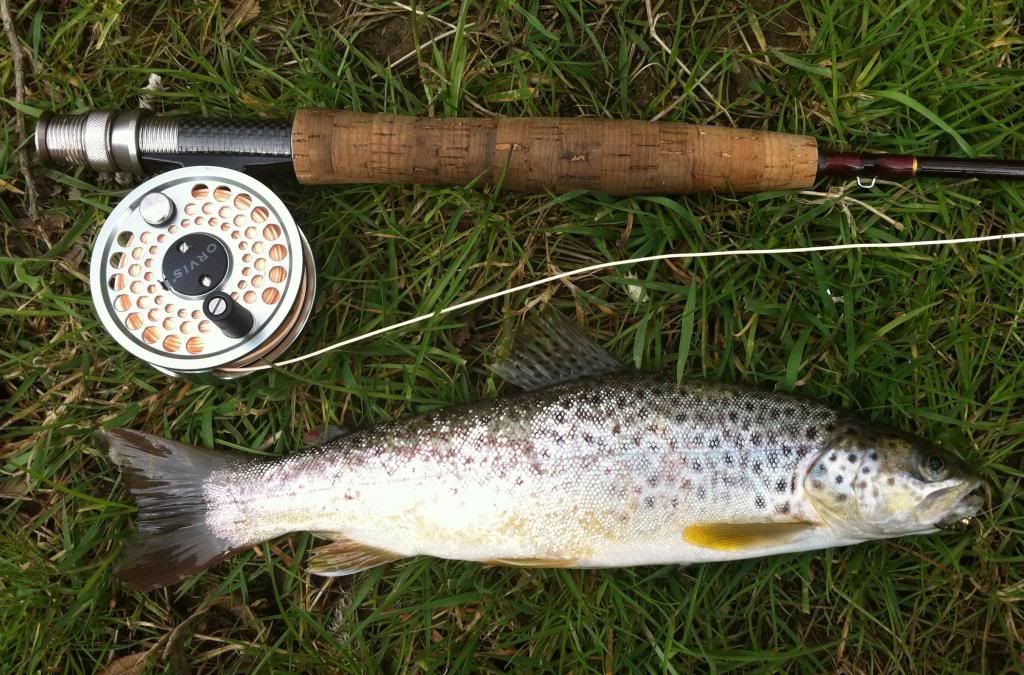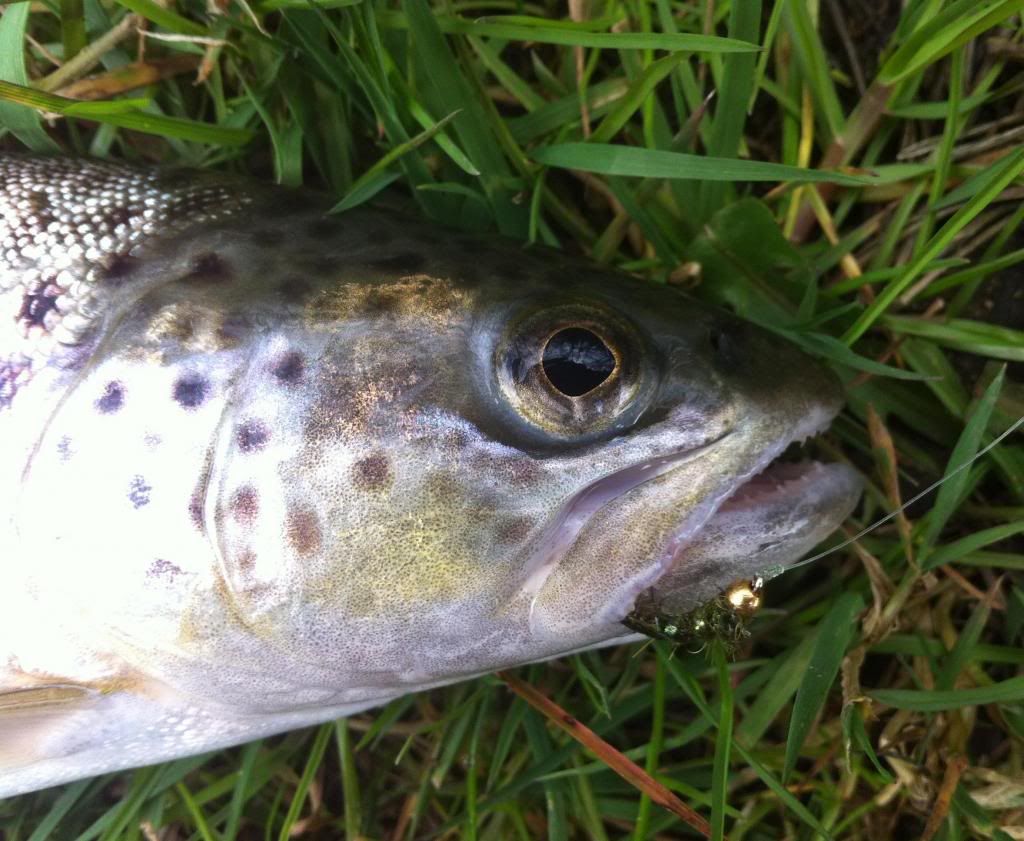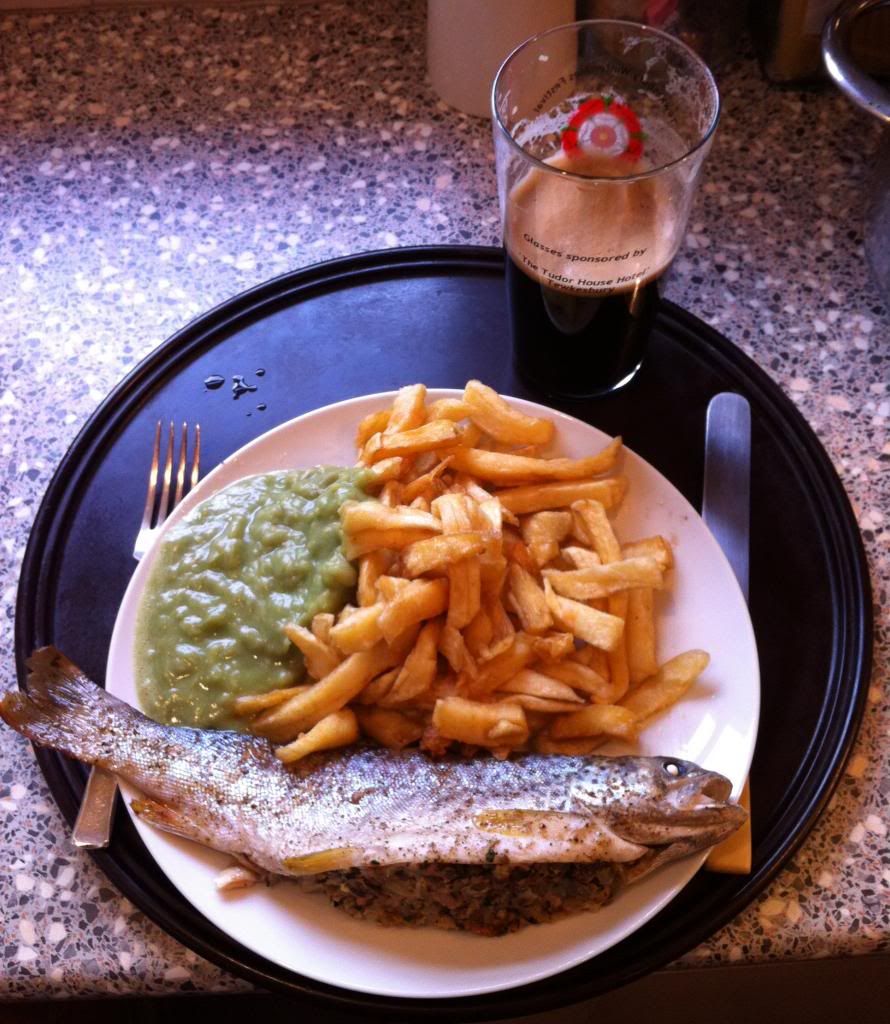For reasons already discussed ad nauseam on this blog I was unable to get to the river for the opening of the game season. And, when I finally got here, it was after a couple days of pretty heavy rainfall; just right for a spot of upstream nymphing.
The Coln was pushing through sharpishly and was not its usual, crystal clear, self. Further, no trout were showing, particularly. A couple of vague shapes were spotted here and there, tight beneath the bank, but certainly nothing was rising.
There are those who state that upstream nymphing is as difficult to master (some say more so) than the upstream dry fly. In certain circumstances it is arguable that this is so. Trout perceive the effects of drag upon flies fished below, as well as on, the surface and nymphing trout in clear, shallow water can be tricky customers. However, when the water is coloured and pushing through, fishing weighted nymphs upstream is not difficult.
Frankly, in these conditions, presentation (say it quietly) is not that important: getting the nymph in the right place, though, is. In conditions such as those described, and especially at the beginning of the season, the majority of fish will most likely be lying in the deepest holes on the beat. Holes with overhead cover are worth particular attention.
Some people don't bother using tapered leaders when nymphing, finding that that the heavy fly will turnover quite easily on a straight line. I do use tapered leaders, finding I cast with greater confidence when using them, and, when fishing a second nymph on a dropper, a tapered leader means a better chance of getting at least one of the pair back if the point fly becomes irretrievably snagged and pulling for a break is the only option. However, tapered or straight is entirely a matter for personal preference.
Bead-headed nymphs are great for getting the fly down to deep lying fish quickly. Gold-headed patterns also have a good visibility factor in coloured water. The fish pictured fell to one of my favourite patterns, a (size 14) gold-headed GRHE variation tied as scruffily as possible, in this case with olive hare's fur dubbing and flat tinsel in place of wire (further visibility), but, vive la difference!, I heartily recommend a free-form jazz experimentation approach in regard to alternative dressings.
Cast upstream and into the kind of likely spots already discussed. Watch the end of the fly line or, if possible, the leader, for any unnatural movement. If the leader or line deviates in any way from its natural course coming back towards you, tighten. Do not strike too heavily; remember, the fish will in all likelihood be facing away from you when it takes so there is no need for heavy handedness. The key is to keep up with the leader as it comes back towards you. Figure-of-eighting, or hand looping, are the preferred retrieves as they keep the line out of the water and, as such, mitigate against a variety of possible issues, but it's not critical. If the flow is too rapid, strip the line in order to remain in contact.
I don't take many fish, and wild fish almost never (none last year) but I took this one (I put back a couple of very nice but, alas, out of season, grayling, taken on the same olive GRHE nymph) and had it with chips and mushy peas from the chippy 'round the corner accompanied by a pint of my own homebrewed stout. A fitting end to my first day of the season.
STUFFED TROUT RECIPE
Ingredients (per whole trout - 12-15 inch fish are tastiest):
1 x rasher of bacon
1 x mushroom
1 x small shallot (or onion - don't use too much. A quarter of a typical supermarket-sized onion is plenty)
1 x egg
chopped dill (or parsley if there's no dill about)
Method:
1) Clean the trout, taking care to remove the black pith that runs along the spine. A teaspoon is the best tool for this. Season the inside of the fish with salt and pepper according to taste.
2) Finely chop the bacon, mushroom and shallot/onion.
3) Melt a generous knob of butter in a frying pan over a moderate heat.
4) Add the chopped ingredients to the pan and sweat - do not brown - the mixture for a few minutes.
5) Remove from the heat, break the egg into the pan and immediately stir into the mixture.
6) Chuck a small handful of dill/parsley into the pan and stir in.
7) Stuff the trout with the mixture, smear sparingly with more butter (or "drizzle" with olive oil if you must) and wrap loosely in cooking foil in such a way that the stuffing is held within the fish. If this cannot be managed, use cocktail sticks to pin the thing closed before foiling.
8) Place in a baking tin and cook (for fish of 12-15") for twenty five to thirty minutes at 170 degrees, or until done.
Notes:
a) Catch, kill and eat your trout in the shortest possible order. The difference between a fresh caught and cooked wild brownie and the insipid, limp, pathetic specimens on sale at Tesco (and other outlets) does not bear comparison.
b) Very fresh fish do not require much cooking - overcooking will ruin the fish. You know the vagaries of your ovens. Have a butcher's after twenty mins.
c) Butter, in this case, really is far superior to olive oil.
d) If at all possible,
Don't: use crappy pre-packed bacon, caged hen eggs and flavourless white mushrooms from the local One Stop Shop.
Do: use organic dry-cured bacon from your friendly neighbourhood butcher, top notch, flavoursome, mushrooms from wherever you can get them and free range eggs, preferably on the day of laying. I get mine from my sister's hens, which also have some promising - looking hackles...
Don't: use crappy pre-packed bacon, caged hen eggs and flavourless white mushrooms from the local One Stop Shop.
Do: use organic dry-cured bacon from your friendly neighbourhood butcher, top notch, flavoursome, mushrooms from wherever you can get them and free range eggs, preferably on the day of laying. I get mine from my sister's hens, which also have some promising - looking hackles...
e) Ensure you have either, or both, of the following to quaff while cooking and eating your catch:
i) Some excellent ale
ii) Some excellent wine (I recommend Muscadet or Sancerre)
Et Bon Appetit!
Credit
I got this from an old fly fishing book but cannot remember which. My apologies, and credit, to the originator and publisher of this recipe.



No comments:
Post a Comment